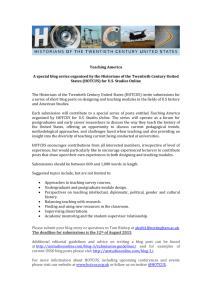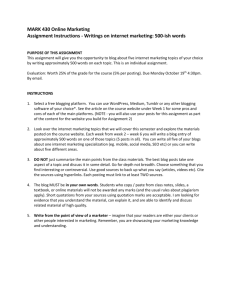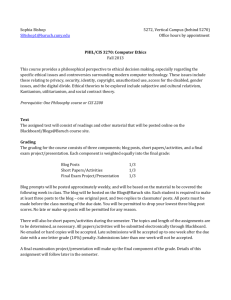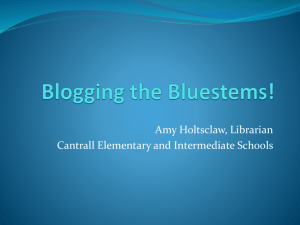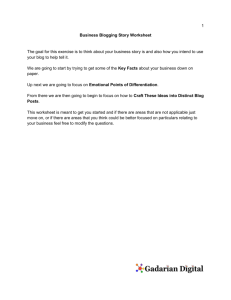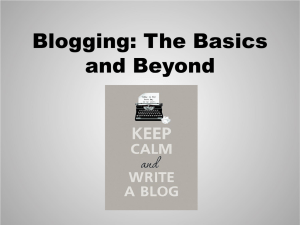ProfHacker – “A Rubric for Evaluating Student Blogs”
advertisement
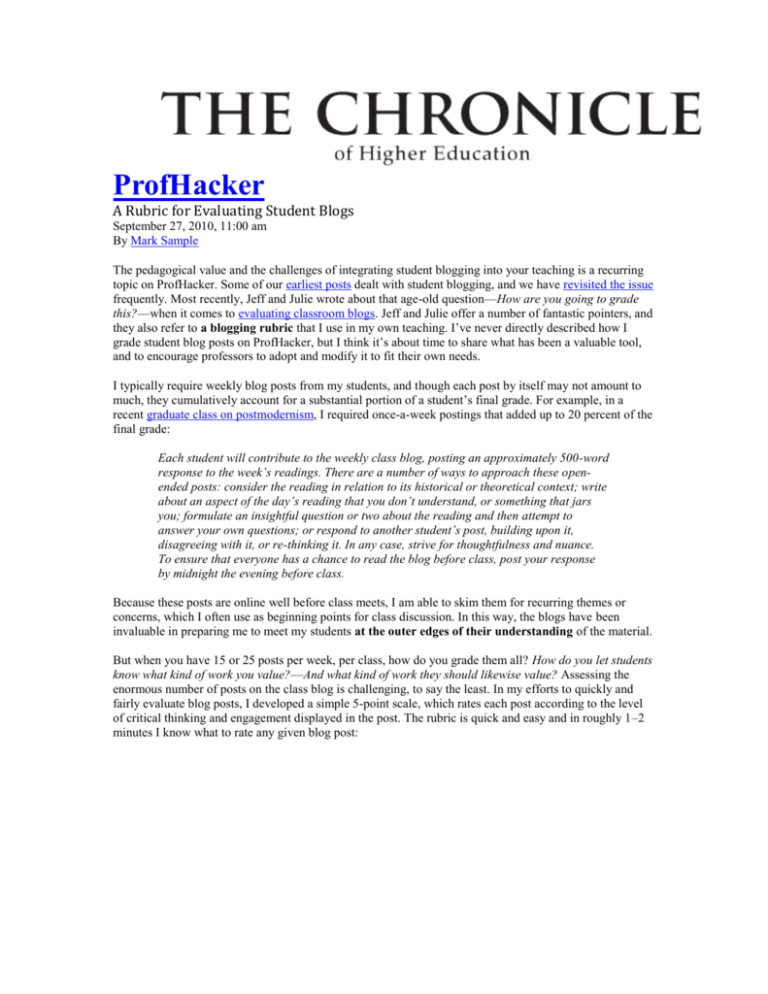
ProfHacker A Rubric for Evaluating Student Blogs September 27, 2010, 11:00 am By Mark Sample The pedagogical value and the challenges of integrating student blogging into your teaching is a recurring topic on ProfHacker. Some of our earliest posts dealt with student blogging, and we have revisited the issue frequently. Most recently, Jeff and Julie wrote about that age-old question—How are you going to grade this?—when it comes to evaluating classroom blogs. Jeff and Julie offer a number of fantastic pointers, and they also refer to a blogging rubric that I use in my own teaching. I’ve never directly described how I grade student blog posts on ProfHacker, but I think it’s about time to share what has been a valuable tool, and to encourage professors to adopt and modify it to fit their own needs. I typically require weekly blog posts from my students, and though each post by itself may not amount to much, they cumulatively account for a substantial portion of a student’s final grade. For example, in a recent graduate class on postmodernism, I required once-a-week postings that added up to 20 percent of the final grade: Each student will contribute to the weekly class blog, posting an approximately 500-word response to the week’s readings. There are a number of ways to approach these openended posts: consider the reading in relation to its historical or theoretical context; write about an aspect of the day’s reading that you don’t understand, or something that jars you; formulate an insightful question or two about the reading and then attempt to answer your own questions; or respond to another student’s post, building upon it, disagreeing with it, or re-thinking it. In any case, strive for thoughtfulness and nuance. To ensure that everyone has a chance to read the blog before class, post your response by midnight the evening before class. Because these posts are online well before class meets, I am able to skim them for recurring themes or concerns, which I often use as beginning points for class discussion. In this way, the blogs have been invaluable in preparing me to meet my students at the outer edges of their understanding of the material. But when you have 15 or 25 posts per week, per class, how do you grade them all? How do you let students know what kind of work you value?—And what kind of work they should likewise value? Assessing the enormous number of posts on the class blog is challenging, to say the least. In my efforts to quickly and fairly evaluate blog posts, I developed a simple 5-point scale, which rates each post according to the level of critical thinking and engagement displayed in the post. The rubric is quick and easy and in roughly 1–2 minutes I know what to rate any given blog post: Rating Characteristics 4 Exceptional. The blog post is focused and coherently integrates examples with explanations or analysis. The post demonstrates awareness of its own limitations or implications, and it considers multiple perspectives when appropriate. The entry reflects in-depth engagement with the topic. 3 Satisfactory. The blog post is reasonably focused, and explanations or analysis are mostly based on examples or other evidence. Fewer connections are made between ideas, and though new insights are offered, they are not fully developed. The post reflects moderate engagement with the topic. 2 Underdeveloped. The blog post is mostly description or summary, without consideration of alternative perspectives, and few connections are made between ideas. The post reflects passing engagement with the topic. 1 Limited. The blog post is unfocused, or simply rehashes previous comments, and displays no evidence of student engagement with the topic. 0 No Credit. The blog post is missing or consists of one or two disconnected sentences. I strive for as much transparency as possible, so it’s essential that my expectations (i.e. the rubric) are explained to the students early on, and always available for them to review later. I also let the students know what their grades are for each post, using my university’s officially sanctioned method of transmitting student grades (that is, Blackboard). Grades are of course a superficial way of showing students what we value. Direct and immediate descriptive feedback does more than a single letter or number can. So in order to deepen students’ understanding of their own work, I comment on every student’s blogging at least twice throughout the semester. These are public comments, posted below each student’s blog post, again contributing to the collaborative and transparent ecosystem of the blog. How about you? If you ask students to blog, how do you evaluate their efforts? Do you have a rubric to share or other tips for our readers? COMMENTS gideonburton - September 27, 2010 at 12:13 pm It is important to distinguish between the evaluation of a blog post (which your rubric is for) and the evaluation of a blog as a whole (which I think is your larger question when you ask about grading them all). I use a simple quantitative expectation (two posts per week) combined with a qualitative, holistic evaluation given in person during a monthly interview. The students need to feel the freedom to blog informally and frequently, and holding them to high standards for each post is both impractical for the teacher and ineffective for the student. The quantitative expectation gets them blogging; the qualitative gets them blogging better. I publish an explicit list of criteria for good blog posts and each class period take time to point out student posts meeting the criteria. Without micro-evaluating each post, their posts increase in quality. Prior to meeting with students individually (monthly), I require them to do a reflective blog post in which they evaluate how well they have met the learning outcomes and blogging criteria. I have also had success in having students use the published criteria to evaluate one another’s blogs (at end of term). This helps me to read students’ blogs more efficiently, and provides proof of how well a student understands criteria when applying them to another’s work.It is critical that blogs not be evaluated as though they are the static, formal, text-only monologues that traditional papers are. They must be evaluated as the living things they (hopefully) have become. This means teaching the value of informal communication and interactivity as much as more formal analysis of ideas. It means teaching concision of communication and designing posts to be attractive both visually and intellectually. It means addressing the function of blogs in building ethos and the online presence of the student; the effective use of media to complement text; linking and referencing; and especially the social nature of digital knowledge. Measuring engagement must include measuring how well they have literally engaged audiences, not just ideas. This is one reason why I require students to comment on others’ blogs (including blogs of those outside of their school), and to contact experts currently working in the topic area of their blog (using what I call “social discovery”). Blogging isn’t learning how to analyze and publish ideas; it’s about acquiring digital literacy, and that literacy is profoundly media-rich and socially mediated. Any rubric that ignores these factors (or that insists on each post being a miniature polished academic essay) reveals a lack of understanding of what blogs are and do. These are the criteria that I use for the research blogs I assign (spelled out in detail at http://bit.ly/blog-criteria):-development-focus-cohesion-post variety-personalitycurrency / history-sources-interactivity-community-analysis-length-links-media-designquantityI’m also happy to point people to example research blogs from my students.Gideon BurtonBrigham Young Universitywakingtiger@gmail.com mark_sample - September 27, 2010 at 1:29 pm @gideonburton: Thanks for you detailed comments, and your own criteria. I agree that we shouldn’t treat blog posts as traditional papers; the reason I use student blogs in the first place is to carve out an intellectual space in which students feel free from the conventions of academic essays. I often describe the blog as a low-stakes place to try out new ideas and play with different voices and tone. I also do something similar to your reflective blog post, and in fact I’ll be writing about this “blog audit” very soon on ProfHacker… karen_franker - September 27, 2010 at 2:59 pm Mark – Thanks for your excellent posting! I was very interested to see your criteria for evaluating student blogs.Here’s a new blog rubric that I recently created for the University of Wisconsin-Stout: http://www.uwstout.edu/static/profdev/rubrics/blogrubric.htmlIt is intended for the assessment of individual student blog entries, including comments on peers’ blogs.Karen FrankerInstructor, Online Professional DevelopmentUniversity of Wisconsin-Stout. v8573254 - September 27, 2010 at 5:41 pm We start with this one: https://my.wsu.edu/portal/page?_pageid=177,276578&_dad=portal&_schema=PORTAL It is a bit more complex than the one presented here, but in our work we have found more sophisticated rubrics, when used well, yield better outcomes. For instance, from a novice users point of view, what is the difference between “in depth engagement” and “moderate engagement”? Rubrics that are educative help define quality as well as describe the judgment in terms that are not simply…judgmental. tishaturk - September 28, 2010 at 9:10 am I like the language of your blog evaluation rubric, Mark, and may be adapting some of it for my own classes; thanks for sharing it!I haven’t had students write blog entries as such; my primary interest in using tech tools is encouraging students to interact with each other, and classroom blogs don’t necessarily facilitate that interaction. Too often, they’re just standard response papers moved online — valuable in their own right, certainly, but not what I’m aiming for. Instead, I have students post regularly to the online forum component of our course software. Each student is responsible for posting something very much like the blog posts you describe here, but they do so only two or three weeks out of the semester (depending on the number of students in the class). The other weeks, they’re responsible for commenting — either on one of the main posts or on another comment. Comments can be shorter than main posts, perhaps just a substantive paragraph or two. So each week we have two or three thoughtful posts that respond to the material in some depth, and then a series of comments taking up threads of those posts and examining them in more detail and from multiple perspectives. The result is more of a genuine conversation than a series of monologues; over the course of a semester, a distinctive discourse community usually starts to emerge. Like you, I find that reading these posts (and comments!) before class gives me a much clearer sense of students’ points of interest and confusion. But the post/comment model also, I think, gives students a sense of the (sometimes quite subtle) differences between posts that are “good” and posts that not only are good but actually prompt conversation. It’s typically the most tentative and exploratory posts, rather than the more polished performances, that open up space for others to respond in complex ways, and I think that seeing this difference in practice, more than any assessment from me, changes the way in which students approach posting over the course of the semester. michaelnelson - September 28, 2010 at 1:24 pm I like Marks’ rubric and may try to incorporate some of it into the criteria I use in future courses.Like some of the others, I evaluate the blog posts students write as a collective body of work. I also provide a provisional “midterm” grade on their blog posts that includes substantive feedback on what they have done and how they can improve.The instructions for students and grading rubric are on this page of my course website: http://africanworldpolitics.site.wesleyan.edu/work-policies/ djplaner - September 29, 2010 at 1:40 am The original rubric we used is here http://webfuse.cqu.edu.au/Courses/2007/T2/COIS20025/Assessment/Item_3/Criteria/It has some similarities with the rubric Mark described.Some description of the rationale for and design of blogs in the course is described in this paper http://davidtjones.wordpress.com/publications/blog-aggregation-management-reducingthe-aggravation-of-managing-student-blogging/Arising out of this work is the Moodle activity module called BIM. BIM is designed to help integrate the marking of externally hosted student blogs into the Moodle LMS, its gradebook, groups etc. more information on BIM can be found here http://davidtjones.wordpress.com/research/bam-blog-aggregationmanagement/ robertwgehl - September 29, 2010 at 11:03 am Mark -This is really useful. I especially agree with the need to comment on blog posts. I’ve found that if I simply write a brief note, something like “That’s a great point. I hadn’t thought about X…”, the students respond to that. One week when I was not feeling so great, I didn’t do that as much, and the students came up in class and asked what they were doing wrong. Just like we bloggers crave comments, Tweets, and feedback, students crave feedback beyond the letter grade. 11888233 - October 11, 2010 at 7:44 pm I am curious, do your institutions have guidelines for student blogs? Are they posted on the web or on an internal site? Do students post under their own names? These are some of the issues I am dealing with at the college where I am dean. crandavj - October 12, 2010 at 1:14 pm Our college uses the blog feature of Blackboard. The guidelines for posts on blogs are included in the general policies for student use of college computational and network resources. These include the netiquette matters of flaming, obscenity, defaming, etc. In my courses students post under their own names.


